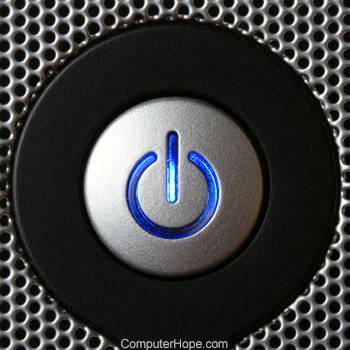When I Starts Pc It Shuts Down Then Starts Again
Why does my computer power on and then immediately turns off?
Updated: 02/01/2021 by Computer Hope

If your computer turns off immediately or even within a few seconds after it is turned on, there could be several possible issues. To proceed, we recommend going through each section below to help find a solution to your problem.
Caution
Some of the steps below require you to open the computer case. While working in your machine, always be aware of the dangers of ESD.
Loose cable
Make sure all cables inside the computer case are firmly attached to the motherboard and each component. Check the IDE cables and SATA cables, which are connected to the hard drive, CD or DVD drive, and floppy drive (if present). Check both ends of each cable and make sure they are firmly attached to the component and the motherboard. Turn on the computer and test to see if this resolves the issue.
Tip
Sometimes, the best way to verify a cable is not loose is to disconnect and reconnect (reseat) the cable on both ends.
Surge protector issues
Surge protectors and battery back-up units can go bad over time, causing reduced power flow to the computer. As computers require a specific amount of power to operate, too great a reduction can force the computer to shut down.
If this situation applies to your computer, unplug its power cord from the surge protector or battery back-up unit, and plug it directly into a wall outlet. Turn on the computer to see if the problem persists. If the computer stays powered on, the surge protector or battery back-up unit is bad and needs to be replaced.
Electrical short
An electrical short in a computer, which may cause power issues, happens when pieces of metal cause a path for electricity to flow through that shouldn't exist. Computers are full of screws, as they hold nearly every internal component in place, and from time to time, they can come loose. Lift your computer and gently rotate it while gently shaking it from side to side. If you hear what sounds like small rocks banging around, you likely have loose screws inside the case. Open the computer up and remove them.
Memory issue
Verify the memory modules are properly seated in the memory slots on the motherboard. To do this, open the computer, remove the memory modules from their slots, and gently reseat them. It also is important to note that memory modules are installed in pairs, and sometimes in matching slots, which are designated by matching colors. Make sure the modules are firmly seated and the clamps on both sides of the modules snap into place. Plug in the power cord and turn the computer on to see if the issue is resolved.
Power supply issues
Power supply voltage switch
The power supply voltage switch, a small red switch on the back of the power supply, may be on the wrong setting. If this switch's setting is not correct for your country, your computer may automatically power down. The first thing to do is to consult the Voltage Valet website to discern your country's correct voltage settings. Then, make sure your power supply voltage switch is set accordingly.
Possibly defective power supply
Verify the power supply is functional. A faulty power supply can result in not enough, if any, power getting to the motherboard, causing the computer to shut off immediately or not turn on at all. Many online computer retailers sell power supply testing units for under $20. In the event of a bad power supply, the only remedy is to replace it with a new one. Fixing a power supply is not an economical solution, if possible at all.
Overheating
If your computer is new or the motherboard was recently replaced, make sure the thermal compound is properly applied to the processor. If the heat is not being properly transferred from the processor to the heat sink, it can overheat very quickly. Because of the potential of damage to hardware that overheats, if the computer exceeds a set temperature, it is automatically turned off.
Motherboard issue
The last thing to check is the motherboard; however, this can be rather difficult since the issue could be anywhere in the circuitry. A faulty, failing, or malfunctioning circuit or component (e.g., capacitor) can cause the computer to shut off immediately or not turn on at all. If none of the recommendations above help resolve the issue, we suggest sending the computer to a repair shop or replacing the motherboard.
Source: https://www.computerhope.com/issues/ch001488.htm
0 Response to "When I Starts Pc It Shuts Down Then Starts Again"
إرسال تعليق